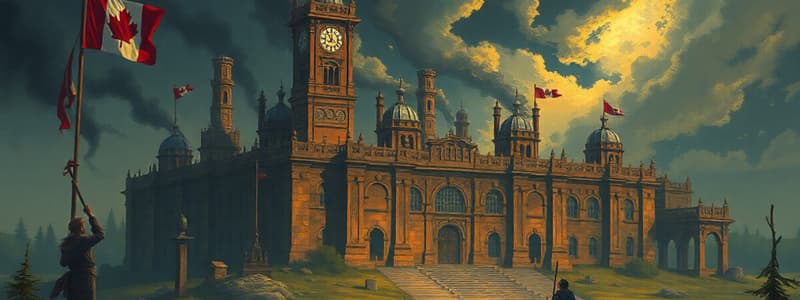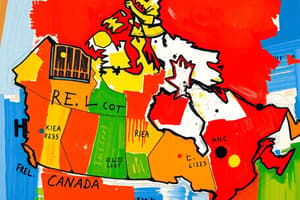Podcast
Questions and Answers
Which of the following best describes the role of the Governor General in Canada's system of government?
Which of the following best describes the role of the Governor General in Canada's system of government?
- Interprets laws and ensures they are applied fairly.
- Leads the Senate in legislative processes.
- Acts as the head of government and leads the ruling party.
- Represents the Monarch and acts as their proxy. (correct)
What was a key factor driving population growth in Canada throughout its history?
What was a key factor driving population growth in Canada throughout its history?
- Significant waves of immigration and economic opportunities. (correct)
- Strict policies on emigration and border control.
- Concentration of the population in rural communities.
- Decreasing birth rates and increased mortality.
Which of these best describes the early Canadian economy following colonization?
Which of these best describes the early Canadian economy following colonization?
- Driven by agricultural exports and large scale farming.
- Primarily supported by resource extraction, particularly fur. (correct)
- Dominated by financial institutions and banking sectors.
- Based on advanced manufacturing and technology.
What is the role of the Canadian judiciary?
What is the role of the Canadian judiciary?
Which significant event led to the establishment of the Dominion of Canada?
Which significant event led to the establishment of the Dominion of Canada?
In Canada's system of governance, what does the term 'responsible government' primarily refer to?
In Canada's system of governance, what does the term 'responsible government' primarily refer to?
Which of the following is a key feature of Canada’s federal system?
Which of the following is a key feature of Canada’s federal system?
What effect did the introduction of Confederation in Canada have?
What effect did the introduction of Confederation in Canada have?
Which of the following best describes a major shift in Canada's economic structure?
Which of the following best describes a major shift in Canada's economic structure?
How did the Catholic Church primarily influence Canadian society?
How did the Catholic Church primarily influence Canadian society?
What factor has most influenced the development of major Canadian cities?
What factor has most influenced the development of major Canadian cities?
Which of these best describes the effects of globalization?
Which of these best describes the effects of globalization?
What is a continuous challenge for city planning and resource allocation in Canada?
What is a continuous challenge for city planning and resource allocation in Canada?
What aspect of Canada's past economy continues to play an important role today?
What aspect of Canada's past economy continues to play an important role today?
What is a characteristic of modern Canadian cities with diverse populations?
What is a characteristic of modern Canadian cities with diverse populations?
What role have government policies historically played in Canada's economy?
What role have government policies historically played in Canada's economy?
Flashcards
What was the British North America Act of 1867?
What was the British North America Act of 1867?
A significant event in Canadian history that marked a major step towards self-governance, bringing together various British colonies into a single nation.
Economic Diversification
Economic Diversification
The process of moving from a mainly agricultural economy to one focused on manufacturing, services, and technology.
Economic Diversification
Economic Diversification
The integration of different economic activities, including agriculture, manufacturing, services, and technology, creating a diverse and complex economic landscape.
What is federalism?
What is federalism?
Signup and view all the flashcards
What was the Fur Trade?
What was the Fur Trade?
Signup and view all the flashcards
Influence of the Catholic Church
Influence of the Catholic Church
Signup and view all the flashcards
What is economic diversification?
What is economic diversification?
Signup and view all the flashcards
Growth of Canadian Cities
Growth of Canadian Cities
Signup and view all the flashcards
What is population growth?
What is population growth?
Signup and view all the flashcards
Growth of Canadian Cities
Growth of Canadian Cities
Signup and view all the flashcards
Describe Canada's government structure.
Describe Canada's government structure.
Signup and view all the flashcards
Competition & Cooperation of Canadian Cities
Competition & Cooperation of Canadian Cities
Signup and view all the flashcards
Who are Indigenous peoples in Canada?
Who are Indigenous peoples in Canada?
Signup and view all the flashcards
Challenges of Urban Development
Challenges of Urban Development
Signup and view all the flashcards
Modern Cities: Complexity & Challenges
Modern Cities: Complexity & Challenges
Signup and view all the flashcards
What are the interactions between Indigenous peoples and Europeans?
What are the interactions between Indigenous peoples and Europeans?
Signup and view all the flashcards
Study Notes
Historical Overview of Canada
- Early colonization by various European powers, including France and Britain, profoundly shaped Canada's political and cultural landscape.
- The fur trade was a crucial early economic activity.
- Indigenous groups possessed diverse cultures and societies prior to European arrival.
- Interactions between Indigenous peoples and Europeans resulted in complex relationships, featuring both conflict and cooperation.
- The British North America Act of 1867 established the Dominion of Canada, a major step toward self-governance.
- Consolidation of British colonies into a single nation occurred through Confederation.
- Subsequent immigration waves greatly influenced population growth and fostered a more diverse culture.
Royal Government and Structure
- Canada's head of state is the monarch of Canada, currently King Charles III.
- The monarch is represented by a Governor General.
- The Canadian government functions as a parliamentary democracy, with the Prime Minister leading the government.
- Legislative power resides in the Parliament of Canada, composed of the House of Commons, the Senate, and the Monarch.
- The Prime Minister heads the dominant political party in the House of Commons.
- Provincial and territorial governments retain autonomy in their respective jurisdictions.
- The judiciary interprets laws and ensures fair application.
- The federal system divides powers between federal and provincial levels.
- Principles of responsible government and democratic accountability form the foundation of the system.
Population Growth
- Population growth is significantly influenced by historical immigration policies and the availability of economic opportunities.
- Numerous immigration waves have shaped Canada's population over the past two centuries.
- Economic prosperity, social programs, and immigration policies largely determine population growth trends.
- Canada's population has become increasingly diverse, reflecting immigration patterns from global regions.
- Urbanization and the development of major cities helped concentrate the population.
- Government policies concerning birth rates and population expansion have evolved over time.
- Projecting continued growth in Canada's population in the coming decades is anticipated.
Economic Diversification
- Post-colonial trade was mainly predicated upon resource extraction, like fur trapping and logging.
- The Canadian economy subsequently diversified, with manufacturing and services emerging as crucial sectors.
- Resources like timber, minerals, and oil remain significant contributors to the economy across many areas.
- Agricultural production continues to play a critical role.
- The service sector, technology, and finance sectors have boosted diversification.
- Globalization has impacted the economy's structure and reach.
- Government strategies have focused on supporting specific industries to encourage economic growth.
Catholic Church Influence
- The Catholic Church held a substantial role in shaping Canada's social and cultural life, particularly among French-speaking communities.
- The Church's influence extended to education, healthcare, and charitable work in these areas.
- The Church's political sway, though significant in certain periods, has lessened over time.
- Establishing hospitals, schools, and charities were key contributions of the Church.
- The Catholic Church's influence on Canadian identity and social views remains an important historical context.
Canadian Cities
- Major Canadian cities have emerged as significant economic and cultural centers, often at crucial transportation junctions.
- Early city development was deeply rooted in trade routes and transportation infrastructure.
- City growth frequently correlates with specific industries or economic activities.
- Competition and cooperation between cities are essential to their development and the entire Canadian economy.
- Urbanization involves challenges in housing, infrastructure, and social services.
- Urban sprawl, in some cases, necessitates adapting city planning and resource allocation.
- Cities have played a vital role in political activity and social movements.
- Contemporary cities grapple with issues stemming from diverse populations and globalized economies.
Studying That Suits You
Use AI to generate personalized quizzes and flashcards to suit your learning preferences.





